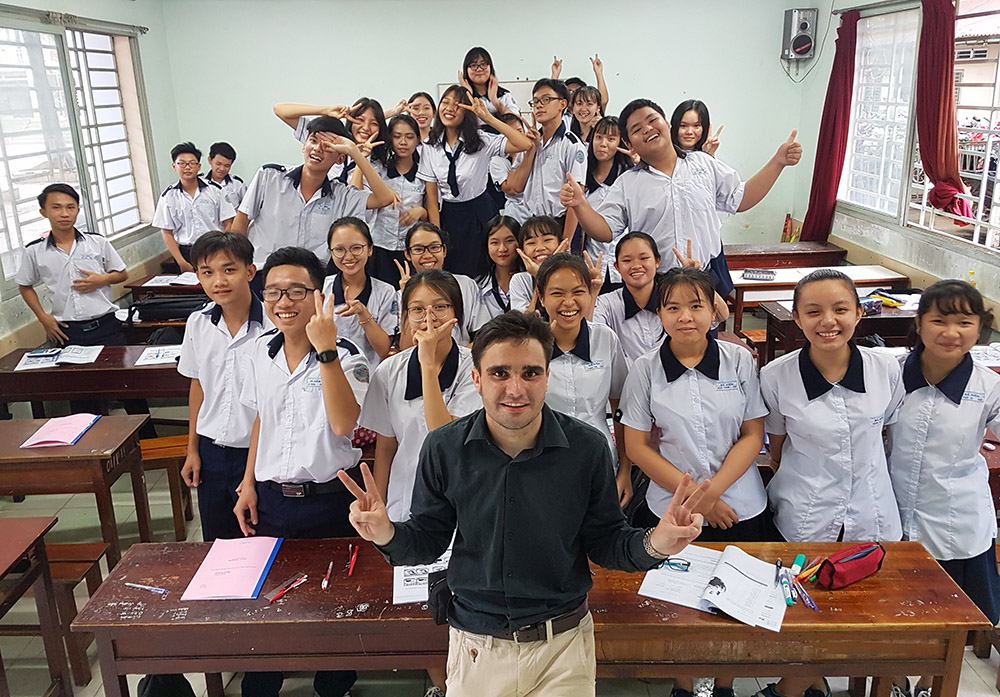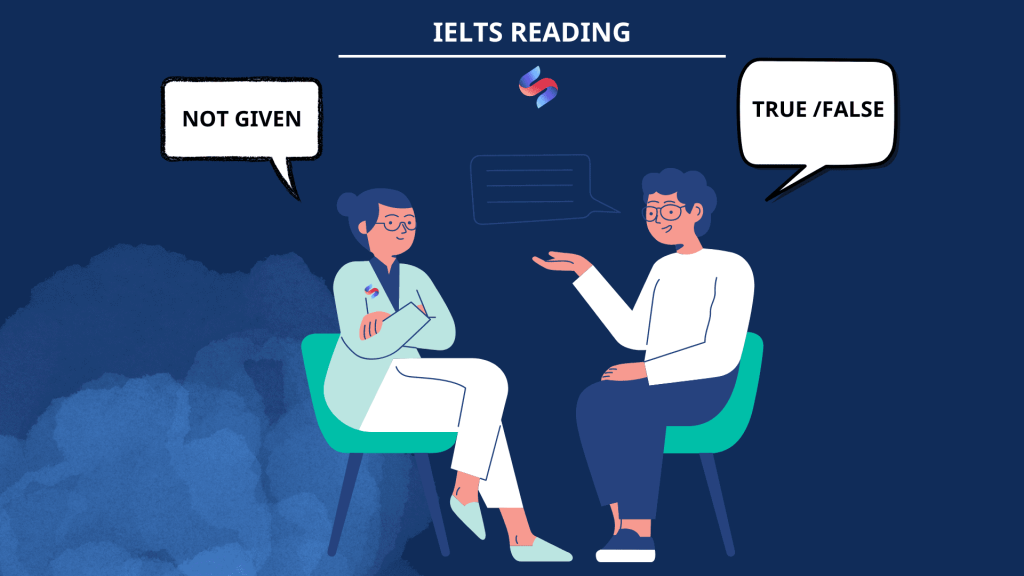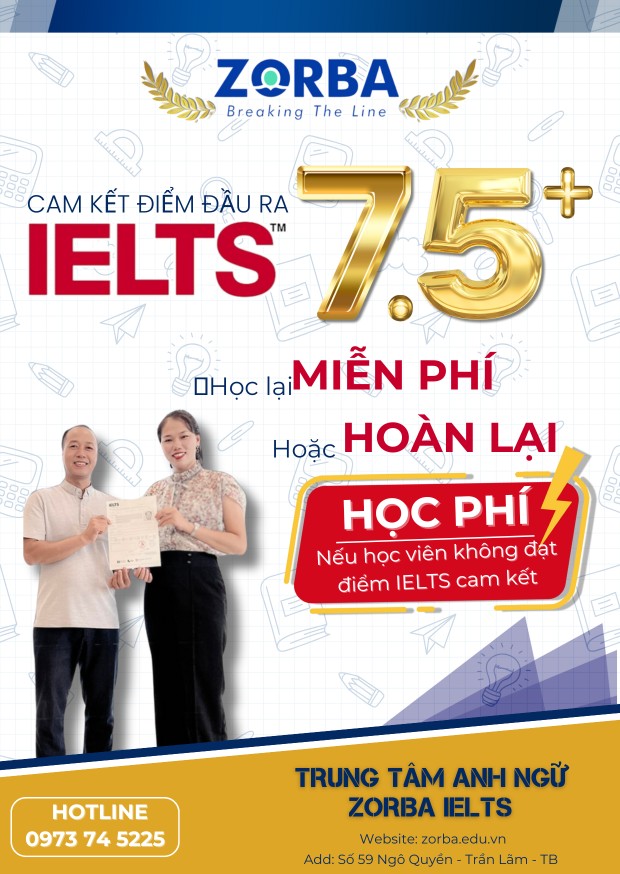Bộ sách luyện đề của Cambridge có thể nói là bộ sách luyện IELTS phổ biến nhất trong cộng đồng luyện thi IELTS. Nhưng để khai thác bộ sách này và luyện tập 1 cách hiệu quả thì như cô Ngân vẫn chia sẻ không thể chỉ làm bài và check đáp án. Các em sau khi check đáp án cần hiểu nội dung bài, học từ vựng, cấu trúc của bài và rút kinh nghiệm cho bản thân.
Nhằm giúp các em có thể khai thác tối đa bộ sách này với các bước như tren, cô Ngân và đội ngũ của ZORBA sẽ lần lượt chữa chi tiết và hướng dẫn cách các em học từ vựng cũng như cấu trúc trong bài để không chỉ áp dụng cho kỹ năng đọc hiểu mà còn cho 3 kỹ năng còn lại.
Dưới đây là 1 ví dụ minh họa trích từ Cambridge 10 các em theo dõi nhé.
Cam 10 test 1- Passage 2
You should spend about 20 minutes on Questions 14-26, which are based on Reading Passage 2 on the following pages.
Questions 14-21.
Reading Passage 2 has nine paragraphs, A-I.
Choose the correct heading for paragraphs A-E and G-1 from the list of headings below.
Write the correct number, 1-xi, in boxes 14-21 on your answer sheet
List of Headings
i A fresh and important long-term goal
ii Charging for roads and improving other transport methods
iii Changes affecting the distances goods may be transported
iv Taking all the steps necessary to change transport patterns
v The environmental costs of road transport
vi The escalating cost of rail transport
vii The need to achieve transport rebalance
viii The rapid growth of private transport
ix Plans to develop major road networks
x Restricting road use through charging policies alone
xi Transport trends in countries awaiting EU admission
EUROPEAN TRANSPORT SYSTEMS 1990-2010
What have been the trends and what are the prospects for European transport systems?
A It is difficult to conceive of vigorous economic growth without an efficient transportsystem. Although modern information technologies can reduce the demand for physical transport by facilitating teleworking and teleservices, the requirement for transport continues to increase. There are two key factors behind this trend. For passenger transport, the determining factor is the spectacular growth in car use. The number of cars on European Union (EU) roads saw an increase of three million cars each year from 1990 to 2010, and in the next decade the EU will see a further substantial increase in its fleet.
B As far as goods transport is concerned, growth is due to a large extent to changes in the European economy and its system of production. In the last 20 years, as internal frontiers have been abolished, the EU has moved from a ‘stock’ economy to a flow economy. This phenomenon has been emphasised by the relocation of some industries, particularly those which are labour intensive, to reduce production costs, even though the production site is hundreds or even thousands of kilometres away from the final assembly plant or away from users.
C The strong economic growth expected in countries which are candidates for entry to the EU will also increase transport flows, in particular road haulage traffic. In 1998, some of these countries already exported more than twice their 1990 volumes and imported more than five times their 1990 volumes. And although many candidate countries inherited a transport system which encourages rail, the distribution between modes has tipped sharply in favour of road transport since the 1990s. Between 1990 and 1998, road haulage increased by 19.4%, while during the same period rail haulage decreased by 43.5%, although – and this could benefit the enlarged EU- it is still on average at a much higher level than in existing member states.
D However, a new imperative – sustainable development offers an opportunity for adapting the EU’s common transport policy. This objective agreed by the Gothenburg European Council, has to be achieved by integrating environmental considerations into Community policies, and shifting the balance between modes of transport lies at the heart of its strategy. The ambitious objective can only be fully achieved by 2020, but proposed measures are nonetheless a first essential step towards a sustainable transport system which will ideally be in place in 30 years’ time, that is by 2040.
E In 1998, energy consumption in the transport sector was to blame for 28% of emissions of CO2, the leading greenhouse gas. According to the latest estimates, if nothing is done to reverse the traffic growth trend, CO2 emissions from transport can be expected to increase by around 50% to 1.113 billion tonnes by 2020, compared with the 739 billion tonnes recorded in 1990. Once again, road transport is the main culprit since alone accounts for 84% of the CO2 emissions attributable to transport. Using alternative fuels and improving energy efficiency is thus both an ecological necessity and a technological challenge.
F At the same time greater efforts must be made to achieve a modal shift. Such a change cannot be achieved overnight, all the less so after over half a century of constant deterioration in favour of road. This has reached such a pitch that today rail freight services are facing marginalisation, with just 8% of market share, and with international goods trains struggling along at an average speed of 18km/h. Three possible options have emerged.
G The first approach would consist of focusing on road transport solely through pricing.This option would not be accompanied by complementary measures in the other modes of transport. In the short term it might curb the growth in road transport through the better loading ratio of goods vehicles and occupancy rates of passenger vehicles expected as a result of the increase in the price of transport. However, the lack of measures available to revitalise other modes of transport would make it impossible for more sustainable modes of transport to take up the baton.
H The second approach also concentrates on road transport pricing but is accompanied by measures to increase the efficiency of the other modes (better quality of services, logistics, technology). However, this approach does not include investment in new infrastructure, nor does it guarantee better regional cohesion. It could help to achieve greater uncoupling than the first approach, but road transport would keep the lion’s share of the market and continue to concentrate on saturated arteries, despite being the most polluting of the modes. It is therefore not enough to guarantee the necessary shift of the balance.
I The third approach, which is not new, comprises a series of measures ranging from pricing to revitalising alternative modes of transport and targeting investment in the trans-European network. This integrated approach would allow the market shares of the other modes to return to their 1998 levels and thus make a shift of balance. It is far more ambitious than it looks, bearing in mind the historical imbalance in favour of roads for the last fifty years, but would achieve a marked break in the link between road transport growth and economic growth, without placing restrictions on the mobility of people and goods.
Questions 22-26 Do the following statements agree with the information given in Reading Passage 2?
In boxes 22-26 on your answer sheet, write
TRUE if the statement agrees with the information
FALSE if the statement contradicts the information
NOT GIVEN if there is no information on this
22 The need for transport is growing, despite technological developments.
23 To reduce production costs, some industries have been moved closer to their relevant consumers.
24 Cars are prohibitively expensive in some EU candidate countries
25 The Gothenburg European Council was set up 30 years ago
26 By the end of this decade, CO2 emissions from transport are predicted to reach 739 billion tonnes.
Giải chi tiết
Câu 14.
1. Nội dung của đoạn chứa thông tin
(1) It is difficult to conceive (hiểu/ nhận ra) of vigorous( mạnh mẽ) economic growth without an efficient transport system. (2) Although modern information technologies can reduce the demand for physical transport by facilitating teleworking and teleservices, the requirement for transport continues to increase. (3)There are two key factors behind this trend. (4) For passenger transport, the determining factor is the spectacular growth in car use. (5) The number of cars on European Union (EU) roads saw an increase of three million cars each year from 1990 to 2010, and in the next decade the EU will see a further substantial increase in its fleet.
2. Giải thích và đáp án
Câu 2 chứa ý chính của đoạn, trong đó vế chứa liên từ “although” là vế phụ, vế chính là vế sau “the requirement for transport continues to increase”. Các câu 3,4,5 giải thích cho ý chính này, trong đó chỉ ra nguyên nhân của “the requirement for transport continues to increase”
-Heading phù hợp nhất là Viii: sự tăng lên của giao thông cá nhân.
Note:
- It is + adj to V.
- Although + S+V, S+V
- There are + N.
- For + N, S+V.
- The number of sth see an increase of x. (số lượng sth chứng kiến 1 sự tăng 1 lượng =x)
Câu 15
1 Nội dung đoạn chứa thông tin
(1) As far as goods transport is concerned, growth is due to a large extent to changes in the European economy and its system of production. (2) In the last 20 years, as internal frontiers have been abolished, the EU has moved from a ‘stock’ economy to a flow economy. (3) This phenomenon has been emphasised by the relocation of some industries, particularly those which are labour intensive, to reduce production costs, (4) even though the production site is hundreds or even thousands of kilometres away from the final assembly plant or away from users.
2.2. Giải thích và đáp án
Câu 1: Sự tăng lên này là do “changes in the European economy and its system of production” – sự thay đổi trong nền kinh tế châu âu và hệ thống sản xuất. Các câu 2,3 giải thích rõ sự thay đổi đó là do “relocation of some industries”- thay đổi địa điểm của các ngành công nghiệp. Câu 4 giải thích rõ hơn: Nơi sản xuất có thể rất xa nơi lắp ghép cuối cùng, và rất xa khách hàng.
Heading phù hợp: iii Những thay đổi mà có ảnh hưởng đến khoảng cách mà hàng hòa được vận chuyển.
Note”
- Due to sth: Vì sth
- As + S+V, S+V: Khi mà…., thì….
- Đại từ Those thay thế cho industries
- Away from sth: xa khỏi sth
Câu 16
1. Nội dung đoạn chứa thông tin
(1)The strong economic growth expected in countries which are candidates for entry to the EU will also increase transport flows, in particular road haulage traffic. (1) In 1998, some of these countries already exported more than twice their 1990 volumes and imported more than five times their 1990 volumes. (3) And although many candidate countries inherited a transport system which encourages rail, the distribution between modes has tipped sharply in favour of road transport since the 1990s. (4) Between 1990 and 1998, road haulage increased by 19.4%, while during the same period rail haulage decreased by 43.5%, although – and this could benefit the enlarged EU- it is still on average at a much higher level than in existing member states.
2. Giải thích và đáp án
Câu 1 là ý chính của đoạn “ Sự phát triển kinh tế ở các nước mà là ứng viên chờ vào EU sẽ làm gia tăng lưu lượng giao thông.”
Các câu sau giải thích cho ý này bằng các thông tin liên quan đến các năm cụ thể.
Heading: xi Transport trends in countries awaiting EU admission
Note:
- The strong economic growth expected in countries which are candidates for entry to the EU /will also increase transport flows, in particular road haulage traffic.
(Chủ ngữ: Lược bỏ ĐTQH trước “expected”- Sự phát triển kinh tế mạnh mẽ mà được kỳ vọng ở các nước mà … thì sẽ làm tăng…)
- And although many candidate countries (S1)/ inherited a transport system which encourages rail (V1), the distribution between modes (S2)/ has tipped sharply in favour of road transport since the 1990s (V2).
- Although S 1+V1, S2+V2.
Câu 17
1. Nội dung đoạn chứa thông tin
D (1) However, a new imperative – sustainable development offers an opportunity for adapting the EU’s common transport policy. (2) This objective agreed by the Gothenburg European Council, has to be achieved by integrating environmental considerations into Community policies, and shifting the balance between modes of transport lies at the heart of its strategy. (3) The ambitious objective can only be fully achieved by 2020, but proposed measures are nonetheless a first essential step towards a sustainable transport system which will ideally be in place in 30 years’ time, that is by 2040.
2. Giải thích và đáp án
Câu 2: Mục tiêu này (mục tiêu được nhắc đến ở câu 1- adapting the EU’s common transport policy) được đồng ý bởi…. phải đạt được bởi (1) integrating environmental considerations into Community policies, and (2) shifting the balance between modes of transport lies at the heart of its strategy.
Câu 3: Mục tiêu này (mục tiêu được nhắc đến bên trên) chỉ có thể đạt được trước năm 2020,…
Tóm lại:
Câu 2: Mục tiêu
Câu 3: Giải thích mục tiêu đó
Heading: A fresh and important long-term goal.
Note:
- (2) This objective agreed by the Gothenburg European Council,(S) /has to be achieved by integrating environmental considerations into Community policies, and shifting the balance between modes of transport lies at the heart of its strategy. (Cái mục tiêu mà được đồng ý bởi the Gothenburg European Council, thì phải được đạt được bởi (1) integrating environmental considerations into Community policies và bởi (2) shifting the balance between modes of transport lies at the heart of its strategy.)
Câu 18
1. Nội dung đoạn chứa thông tin
(1) In 1998, energy consumption in the transport sector was to blame for 28% of emissions of CO2, the leading greenhouse gas. (2) According to the latest estimates, if nothing is done to reverse the traffic growth trend, CO2 emissions from transport can be expected to increase by around 50% to 1.113 billion tonnes by 2020, compared with the 739 billion tonnes recorded in 1990. (3) Once again, road transport is the main culprit since alone accounts for 84% of the CO2 emissions attributable to transport. Using alternative fuels and improving energy efficiency is thus both an ecological necessity and a technological challenge.
2. Giải thích và đáp án
Câu 1: Tiêu thụ năng lượng trong giao thông tạo ra 28% lượng CO2, khí gây hiệu ứng nhà kính hàng đầu.
Câu 2: Giải thích rõ số liệu khí thải này.
Câu 3: Once again, nhấn mạnh lại ý của các câu trên.
Heading: v The environmental costs of road transport
Note:
- – be blame for : chịu trách nhiệm cho/ – emissions of CO2, the leading greenhouse gas. Phía sau dấy phảy giải thích cho vế trước. CO2 =khí hiệu ứng nhà kính dẫn đầu.-
- According to the latest estimates ( căn cứ vào những ước lượng gần đây nhất) , if nothing is done to reverse the traffic growth trend( nếu không gì được thực hiện để đảo lộn xu hướng phát triển giao thông) , CO2 emissions from transport can be expected to increase by around 50% to 1.113 billion tonnes by 2020, ( lượng phát thải CO2 có thể được dự đoán tăng 50% đạt 1.113 tỉ tấn trước 2020) compared with the 739 billion tonnes recorded in 1990.( trái với 739 tỉ tấn được ghi nhận năm 1990_
- According to sth: Căn cứ vào sth
- If S+V, S+V.
- S+V, compared to sth
Câu 19
1.Nội dung đoạn chứa thông tin
(1)The first approach would consist of focusing on road transport solely through pricing.
(2) This option would not be accompanied by complementary measures in the other modes of transport. In the short term it might curb the growth in road transport through the better loading ratio of goods vehicles and occupancy rates of passenger vehicles expected as a result of the increase in the price of transport. However, the lack of measures available to revitalise other modes of transport would make it impossible for more sustainable modes of transport to take up the baton.
2. Giải thích và đáp án
Câu 1 là ý chính các câu còn lại giải thích cho ý chính ở câu 1.: Cách thứ nhất là chỉ tập trung vào hệ thống đường bộ thông qua Pricing- thu phí.
Heading: x Restricting road use through charging policies alone
Note:
- Approach (n): Hướng tiếp cận, phương pháp.
- consist of sth (v): Bao gồm
- focus on (v): Tập trung vào sth
- be accompanied by ( bị động): được hộ tống bởi, được đi kèm cùng với
- Curb (v): Kiềm chế, chế ngự sth
- Growth in sth (n): Sự tăng về sth
- Xét về ngắn hạn thì nó (cái phương pháp bên trên) có thể kiềm chế sự tăng lên của giao thông đường bộ thông qua a và b. Trong đó a và b là 2 cụm danh từ
- The lack of sth: sự thiếu hụt sth
- revitalise: làm mới, đem lại sức sống
- Make it impossible for st to V sth: Làm cho nó trở nên bất khả thi cho cái gì đó để làm gì.
Câu 20
1. Nội dung đoạn chứa thông tin
(1) The second approach also concentrates on road transport pricing but is accompanied by measures to increase the efficiency of the other modes (better quality of services, logistics, technology). (2) However, this approach does not include investment in new infrastructure, nor does it guarantee better regional cohesion. (3) It could help to achieve greater uncoupling than the first approach, but road transport would keep the lion’s share of the market and continue to concentrate on saturated arteries, despite being the most polluting of the modes. (4) It is therefore not enough to guarantee the necessary shift of the balance.
2. Giải thích và đáp án
Câu 1: (Cách thứ 2 cũng tập trung vào tính phí đường bộ nhưng đi kèm cùng các giải pháp khác để tăng tính hiệu quả của các phương thức khác.)
Các câu sau giải thích rõ hơn cho ý của câu Khi đọc lướt sẽ thấy chủ ngữ của các câu 2,3,4 là các đại từ thay thế cho “approach” ở câu 1, tức nó đơn giải đưa ra thông tin giải thích rõ hơn cho “the appoach” ở câu 1.
Heading: ii Charging for roads and improving other transport methods
Note:
- Concentrate on (v): tập trung vào sth
- Investment in (n) sự đàu tư vào sth
- nor does it guarantee better regional cohesion. (Đảo ngữ với “Nor” mang nghĩa phủ định: Nó cũng không đảm bảo 1 sự kết nối địa phương tốt hơn.)
Câu 21
1. Nội dung đoạn chứa thông tin
(1) The third approach, which is not new, comprises a series of measures ranging from pricing to revitalising alternative modes of transport and targeting investment in the trans-European network. (2) This integrated approach would allow the market shares of the other modes to return to their 1998 levels and thus make a shift of balance. It is far more ambitious than it looks, bearing in mind the historical imbalance in favour of roads for the last fifty years, but would achieve a marked break in the link between road transport growth and economic growth, without placing restrictions on the mobility of people and goods.
2. Giải thích và đáp án
Câu 1: Cách thứ 3 cái mà không mới, bao gồm 1 loạt các giải pháp từ đánh phí đến làm mới các phương thwucs thay thế và hướng đến đầu tư vào mạng lưới giao thông ở Châu Âu.
Các câu sau giải thích cho ý chính này.
Heading: iv Taking all the steps necessary to change transport patterns
Note:
- Comprise (v) bao gồm sth
- a series of sth: 1 chuỗi sth
- range from sth to sth: có phạm vi từ sth to sth
- ranging bổ nghĩa cho danh từ measures ở trước nó.
- Biện pháp thứ 3 cái mà ko mới thì bao gồm 1 chuỗi các giải pháp từ a tới b và c. Cụ thể a,b,c là 3 measures.
- Allow st to V
- S would (a) allow the market shares of the other modes (sth) to return to (to V) their 1998 levels and (a) thus make a shift of balance.
- Chủ ngữ sẽ a và b. trong đó a và b là 2 cụm động từ nguyên thể.
Câu 22
1. Nội dung câu hỏi
The need for transport/ is growing,/ despite/ technological developments.
(Nhu cầu về giao thông đang tăng bất chấp sự phát triển của công nghệ.)
2. Giải thích và đáp án
Although modern information technologies can reduce the demand for physical transport by facilitating teleworking and teleservices, the requirement for transport continues to increase.
- Mặc dù công nghệ thông tin hiện đại –modern information technologie = technological developments
- Nhu cầu về giao thông tiếp tục tăng the requirement for transport continues to increase= The need for transport/ is growing.
Câu 23
1. Nội dung câu hỏi
To reduce production costs,/ some industries /have been moved /closer to /their relevant consumers./
– Để giảm chi phí sản xuất, 1 vài ngành công nghiệp đã được chuyển đến gần hơn với khách hàng của họ.
2. Giải thích và đáp án
…the relocation ( sự thay đổi vị trí) of some industries, particularly those which are labour intensive, to reduce production costs (để giảm chi phí) , even though the production site is hundreds or even thousands of kilometres away from the final assembly plant or away from users. ( cách xa người tiêu dùng) –F
- Closer- Away
Câu 24
1. Nội dung câu hỏi
Cars/ are prohibitively expensive/ in some EU candidate countries.
(Ôtô rất đắt đỏ ở các nước ứng cử viên chờ vào EU.)
2. Giải thích và đáp án
Không có thông tin này trong bài. NG
Câu 25
1. Nội dung câu hỏi
The Gothenburg European Council /was set up/ 30 years ago.
(Chủ ngữ được thành lập 30 năm trước. )
2. Giải thích và đáp án
Không có thông tin này trong bài. NG
Câu 26
1. Nội dung câu hỏi
By the end of this decade,/ CO2 emissions from transport /are predicted/ to reach 739 billion tonnes.
(Đến trước cuối thập kỷ này, lượng phát thải CO2 từ giao thông được dự đoán đạt 739 tỉ tấn.)
2. Giải thích và đáp án
CO2 emissions from transport can be expected to increase by around 50% to 1.113 billion tonnes by 2020, compared with the 739 billion tonnes recorded in 1990.
lượng phát thải CO2 từ giao thông được dự đoán tăng 50% đặt mức 1.113 tỉ tấn, so với 739 tỉ tấn năm 1990.
Vậy đến trước cuối thập kỷ này, lượng phát thải CO2 từ giao thông được dự đoán đạt 1.113 tỉ tấn chứ không phải 739 tỉ. F
Bên trên là 1 ví dụ trong khóa học IELTS READING BOOSTER tại ZORBA. Cụ thể, sau khi các em đã được học kỹ về các chiến thuật làm bài cho từng dạng bài đọc cụ thể các em sẽ được hướng dẫn để giải toàn bộ bài đọc READING trong bộ Cam 7-15. Các em nhớ luyện tập chăm chỉ chắc chắn sẽ tiến bộ và đạt mục tiêu.














